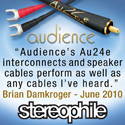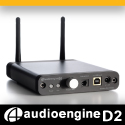|
|
You are reading the older HTML site
Positive Feedback ISSUE 63
wireworld Oasis 6 Interconnect and Loudspeaker, and the Starlight 6 Digital Cables as reviewed by John Hoffman
One sliver of audio wisdom that has been difficult and costly for me to acquire, is that high quality audio playback should always be in style, no matter the current trends. Over the years new audio concepts are introduced, improvements in manufacturing technology are instituted, and the application of exotic or alternative materials results in significant changes to the audio landscape. This particular story line is played out with regularity in the world of cable manufacturing. New formulations for wire are concocted, alternative wire geometries are put forth, dielectric materials are changed, and the latest terminations are presented to the public in order to entice the hobbyist into pursuing one more upgrade. The cycle of change moves on, and even veteran audiophiles can lose sight of established companies and products as easily as the newly initiated hobbyists who are unaware of the history of the cable world. Even writers can fall into this kind of rut, which is why I have made a determined effort this year to revisit the products of several established cable companies and reacquaint myself with their products. David Salz is the founder of WireWorld cables, and designer of the DNA Helix wire geometry, which has been the blueprint for the company's products since its introduction in 2007. The premise underlying the DNA Helix geometry is that audio signal flow in a wire does not occur through electron transfer within the wire, but instead occurs in the electromagnetic field that surrounds the wire. Sound quality is not improved by reducing resistive loss by using thicker conductors, but instead the effects of inductive loss need to be minimized. Inductive loss is uneven in a cable design, and is capable of altering the shape of the musical waveforms passing through the wire. The DNA Helix is a stacked array of flat conductors that is arranged to minimize the effects of electromagnetic signal degradation. Composilex is a proprietary dielectric insulation developed by WireWorld that minimizes modulation distortions, with the results in a lower noise floor than can be achieved by pure Teflon insulation. The combination of cable geometry and dialectic insulation is the result of the culmination of many years of experience in the wire manufacturing process. Larry Smith the National Sales Manager of WireWorld and David Salz conferred over product selection, as I had requested the products they felt offered significant value to the frugally minded audio hobbyist. In the end, the decision was made to send out the Oasis 6 speaker wire and interconnects, and the Starlight 6 digital audio cable. One interesting bit of information to come out of my conversations with Larry is that most cables are terminated in house, and materials are specifically designed and built to required specifications. Even with their value series of products, WireWorld does not use low cost off the shelf wire or connectors, but strive to offer the highest quality of cable within their means at any given price point.
The Oasis 6 interconnect is built with Oxygen Free Copper wire that is arranged in the DNA Helix Quad geometry. Composilex dielectric encases the OFC copper wire, which is a sophisticated material to use on a modestly priced interconnects. The connectors are from the Silver Tube series, with contacts produced from OFC copper and are silver plated. Either RCA or XLR plugs are available. The Oasis 6 sell for $109.95 a meter pair, which should have strong appeal to the value conscious hobbyists who refuses to compromise the sound quality of their audio system.
The speaker wire in this line is without a doubt robust, as it is contains four conductors per leg with an aggregate size of 10AWG. Oxygen Free Copper that undergoes a grain optimization process when it is drawn is selected for this cable. The grain orientation of the wire is controlled, and results in improved audio performance. All WireWorld speaker cables are marked for directionality as a result of the grain structure of the wire, so in this case there is indeed a purpose behind these markings. Wire geometry is the DNA Helix configuration, with insulation composed of High Density Polyethylene (HDPE). Either Silver Spade or Silver Banana plug terminations are available. These connectors are an OFC copper with a heavy coat of silver plating to improve conductivity. An eight foot pair of Oasis 6 speaker wire sells for $324.95, which is an attractive price for a cable of this gauge and construction.
With a price tag of $79.95 the Starlight 6 digital cable completes this affordable package of WireWorld cables. Even though the cost of this cable is modest, the materials and construction are on par with cables that cost significantly more. The Starlight 6 is a scaled down version of the Silver Starlight 6 digital cable, which has been well received in the market place, but does require a significantly greater out lay of cash. The cable geometry is once again the DNA Helix pattern, but the wire used is a silver-clad Ohno Continuous Cast Copper. OCC copper is the highest grade copper wire available, and the while the silver coating is lighter than the Silver Starlight, it still maintains a large degree of the transmission characteristics of the more advanced cable. The shield in the Starlight 6 is also silver-clad, although made of Oxygen Free copper, which is more than acceptable for this task. Compoislex insulation technology is also used on this cable; just as in the Oasis 6 interconnects. The Silver tube RCA or BNC connectors are used in this design, which use an OFC contact with silver plating. The last issue of PFO introduced the TBI Audio Millenia MG3 digital amplifier, which has redefined for me what is possible with affordable audio equipment. I held over the amplifier to use with the WireWorld cables, for this pairing of amplification and wire creates a seriously musical system. The Oasis 6 interconnects are used between the Millenia and the Audio Magic Kukama DAC. The heft of the speaker cables require that I place this compact amplifier on its side, for I suspect that these cables may actually outweigh the amplifier. The Starlight 6 digital cable connects an EAD T1000 transport to the Kukama DAC. A hundred hours of burn in were given to all the wires before serious listening sessions began, although when I spot checked them I found no significant changes after the 50 hour mark. When auditioning moderately priced audio equipment, my primary concern is the music enjoyable, and does the component under consideration engages me as a listener. At moderate price points I can live without the highest degree of transparency, and can give up a bit of frequency extension at either end of the musical bandwidth. What I require is an articulate and well balanced midrange band and an absence of grain or coarse texture of the music. The Oasis 6 speaker cables went into the system first, primarily due to the fact that its material make up is closer in approximation to the ZU Audio Mission speaker wire that is currently in my system. In theory these wires have the chance to sound closer to each other than interconnects do, since the Mission interconnect uses a silver coating over copper wire. Into the CD player went Mood Swing [Mood Swing; Warner Bros. 9 45643-2] by the Joshua Redmond Quartet. When the opening track began, I was greeted by a sound that is rarely heard from budget priced cabling. The Oasis 6 speaker wire presents music in a rich and full bodied tonal balance that is smooth and has an easy flow. On "Sweet Sorrow" Redman's saxophone has huge tone, and has a ‘warmth’ that makes the song intimate and inviting. The stand up bass is resonant, and has believable texture and definition. The drum kit has some limitations to the decay of the snare and tom drum heads, but the overall sound quality is still quite good for the price. The cymbals and higher frequency piano notes are smooth and easy to listen to, but lack that final degree of transparency that higher performance wire is capable of. The Oasis 6 speaker wire acquits itself admirably when asked to reproduce female vocals. Suzanne Vega's vocals on "Tom's Diner" [Solitude Standing; A&M Records CD5136] are dark, refined, and introspective, yet still convey all the subtle texture of her distinctive singing style. This whole album is brooding, with an aura of melancholy to the music. This is an aspect that the WireWorld cable adroitly conveys. Natalie Cole is an artist who has a lighter touch with her vocal style, and her music presents a different challenge to the speaker cable. Once again the defining characteristic of the sound is a full and robust midrange that has a gentle and easy going presentation of Natalie's vocals. On "The Very Thought of You" [Unforgettable; ELEKTRA 9 61049-2] there is a burnished warmth to Cole's voice, yet the upper midrange region still has admirable detail and definition. Even when asked to present divergent types of music, the Oasis 6 speaker cables steadfastly retains its character and consistently presents the material in a manner that is both engaging and easy to listen to. Next up are the Oasis 6 interconnects, and the installation of these cables resulted in a fundamental change in the overall character of music in my listening room. The installation of these cables completed a transformation of sound, pulling my system back from a precipice that teetered on the edge of a cold and clinical presentation of music. Through careful component selection and system set up I have always kept this undesirable aspect of my system in check, but it lies beneath the surface threatening to break through if the wrong decision is made. The WireWorld interconnect brings an additional degree of smoothness and refinement to the system that the speaker wire did, yet does not take the sound too far in the opposite direction. As I recall, my first exposure to the music of Kate Bush was Hounds of Love, and it has always been one of my favorite albums. The second half of this album has a distinct Pink Floyd influence, with multiple combinations of instruments, recorded environmental sounds, and synthesized events created solely in the studio. The sonic signature of "Waking the Witch" [Hounds of Love; EMI D 101779] is slightly dark, and dense due to the multiple tracks layered throughout the song. The WireWorld interconnects relay the complex textures within the music nicely, and keep everything from becoming an opaque mess. Performers and instruments are reasonably well formed and placed clearly within the sound stage. The only significant limitation I experienced is that spatial cues of the song lacked the final degree of definition, and suffered a degree of shortening of ‘front to back’ depth. However, for a modestly priced cable, the Oasis 6 competently completes all the tasks one would ask. Audio components with a warm and easy going nature often get overwhelmed when music becomes complex while undergoing large swings of dynamic contrasts. This is not an issue with the Oasis 6 interconnects; for in my listening sessions I was impressed with how it handled complex music. In working through the various tracks on A Passage in Time from the Dead Can Dance, I found that this cabling system had a deft balance between full bodied presentations, and still has the ability to convey energy and attack within the music. On the opening track "Saltarello" [A Passage In Time; RYKODISC RCD 20215] the Oasis 6 cable did a fine job of contrasting the dynamic scales between percussion instruments, the reeds, and the cymbals. Overall volume never became compressed, and the micro dynamic cues that define each instrument are properly sorted out. This ability to preserve dynamic scale to the music means that these cables have a lively pace, and a proper texture, which is not often the case when a wire has a romantic character. The hidden gem within the package of cables that WireWorld sent me is the Starlight 6 digital cable. The Starlight 6 was the last piece to go into my system, and inadvertently I saved the best for last. This cable is a few steps closer to neutral than the Oasis 6 wires, and the suite of cables balances itself out nicely, finding an equilibrium point that melds resolution with an ‘easy on the ears’ presentation. Revisiting "Tom's Diner", Suzanne Vegas voice gets a touch lighter in terms of tone, and it becomes easier to hear the subtle inflections she brings to various phrases. The slight degree of heavy handedness of the Oasis speaker wire is deftly countered in this instance. Returning to "Waking the Witch" by Kate Bush, I find the localization and separation of instruments and sounds to be improved. The song gains clarity and focus, which makes it easier to hear the layering within the song. To a degree, the shortening of sound stage depth is countered, and a small portion of space is created. Even the presentation of dynamic contrasts is affected by the Starlight 6 cable. The Dead Can Dance piece gains speed and transparency, which creates a greater degree of distinction between the dynamic attributes of each instrument. The dynamic signatures of all instruments at both the macro and micro level are affected, which also improves the timing and overall pace of the system. I verified this point by returning to "Mood Swing", and found that the music gained a tic in tempo, and the overall feel to the song was lighter in texture. With basically an $80 price tag, the Starlight 6 digital cable is an absolute steal. David Salz believes that the ultimate connection between components is no cable at all, so he has developed a test methodology in which a direct link is made between components. Through measurement and listening tests, the direct link is the yardstick that WireWorld cables are evaluated against. This goal is what I would expect a state of the art product to strive for, but is not a realistic goal for an affordable cable to achieve. For their cost conscious line, WireWorld's overriding philosophy is to build cables that preserve harmonic texture and accurately present dynamic contrasts. The Oasis 6 speaker wire and interconnects are warm and full bodied, yet have the ability to maintain an acceptable degree of transparency and clarity. The price of both the speaker wire and interconnects should be extremely attractive to the hobbyist who place an emphasis on value for the dollars spent. The Starlight 6 digital cable is a remarkable product that has no right to perform the way it does for $80. I found the Starlight 6 to be the equal of the Analysis Plus Digital Oval cable, which sells for just shy of $200. Certainly these cables are not perfect for there are compromises that accompany products that are in the value niche of the market. The Oasis series of wires are on the warm side of neutral and lack that final degree of transparency that is realized with other upper tier WireWorld cables. This point also holds true for the Starlight 6, although this cable moves closer to the center of the tonal spectrum. Despite any limitations these cables have, I feel they offer significant value at their price points, and that all frugal audio hobbyists would be well advised to give them a serious audition. John Hoffman
Starlight 6
Oasis 6 Interconnect
Oasis 6 Speaker
WireWorld
|








